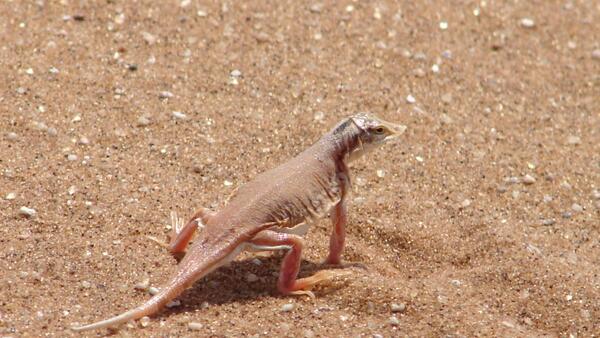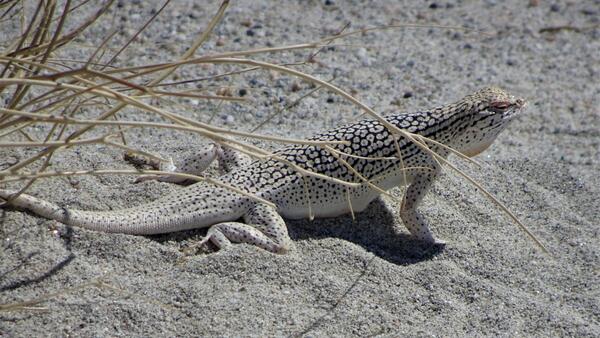North America's deserts vs. the world
“In conclusion, it appears that nothing can be more improving to a young naturalist, than a journey in distant countries.” — Charles Darwin
By DR. CAMERON BARROWS
Deserts are found on every continent (yes, even Antarctica). Europe has Cabo de Gata in Almería, Spain's south-east corner, where annual rainfall is just 200 mm – the lowest in Europe. Any region with an average rainfall of less than 10 inches (roughly 250 mm) is a desert. The oldest deserts include the Atacama in South America (~10-15,000,000 years old), the Gobi in Asia (~10-45,000,000 years old), the Kalahari in southern Africa (~60,000,000 million years old), and the oldest, also in southern Africa, the Namib (~50-80,000,000 years old). North Africa’s Sahara Desert is thought to be as much as 7,000,000 years old. However, human-etched petroglyphs of antelope and giraffes on rock cliffs exposed through the sea of sand dunes in the central Sahara indicate that at least portions of the Sahara were much wetter more recently than that estimate of the aeolian sand sea’s antiquity.
By comparison, North America’s deserts are relatively new. Some vegetation that today we associate with our deserts has been found in late Miocene (~5-6,000,000 years ago) fossil deposits, however, the repeated glacial maxima throughout the Pleistocene (12,000 – 2,000,000 years ago) resulted in fluctuations from warmer-drier conditions to non-desert, cooler and wetter conditions across much of what we now call the California deserts. During those cool-wet periods desert-like vegetation and animals were likely restricted to low elevations and south-facing mountain slopes. The current configuration of the Colorado and Mojave Desert did not begin to take shape until after 12,000 years ago. Major sand dune systems such as the Kelso Dunes in the Mojave Desert have origin dates going back as far as 9,000 years ago. In the hotter and drier Colorado Desert, the Algodones Dunes maybe twice as old, forming some 18,000 years ago.
Despite the difference in ages between North American and southern Africa’s deserts, and that completely different lineages of plants and animals that reside there, rather than a venturing into a foreign landscape there is a feeling of familiarity between both regions. In the Namib, tree aloes, sometimes called quiver trees (Aloidendron dichotomum) look surprisingly similar to Joshua trees. Native aloes are restricted to sub-Saharan Africa, whereas native yuccas are only found in North America and islands of the Caribbean and are representatives of completely different plant families (aloes – Asphodelaceae; yuccas – Asparagaceae). Native cacti only occur in North and South America (including the Caribbean islands), yet in the Namib there are plants that are almost identical to cacti, including a milkweed – Hoodia gordonii (Asclepidaceae) and spurge – Euphorbia virosa (Euphorbiaceae). There are also similar-looking animals, including a fringe-toed lizard, the shovel-snouted lizard, Meroles anchietae, and a sidewinder lookalike, Péringuey’s adder, Bitis perengueyi. Our fringe-toed lizard belongs to the family Phrynosomatidae, whereas the African lizard belongs to Lacertidae. The adder belongs to the family Viperidae, as do our sidewinders, although they belong to separate subfamilies. The adder lacks a rattle, but they and our sidewinders leave almost identical tracks across the surface of their respective sand dune habitats.
There are of course substantial differences between the Namib Desert’s biota compared to those found in the California deserts. Rather than our 30 or so species of lizards, the Namib has at least 55 species. Those include a chameleon and a gecko with webbed toes, not just fringes. Although we have six different species of fringe-toed lizards (counting northern Sonora, Mexico) each occurring on different, isolated dune systems, within the Namib Desert two occur together, one preferring the dune crests and avalanche faces, the other preferring flatter habitat with scattered shrubs. Give a desert as much as 80,000,000 years and nature (natural selection) allows species to radiate into many more species, dividing the habitats into finer slices.
What I find even more interesting are the similarities between unrelated species groups. Across very similar sand dune habitats and nearby rock outcrops (called inselbergs in southern Africa) natural selection works as a mechanism to maximize the chances for survival. In doing so, the outcomes, even in widely separate locations, can be much the same. The phenomenon is called convergent evolution. Across an ocean, and between unrelated lineages, but in otherwise very similar habitats, species “converge” onto similar solutions, similar body plans. Milkweeds and spurges (Euphorbias) converge toward thick, spongy, leafless stems (for water storage and avoiding water loss through leaves) and spiny skins (to deter being eaten) and look strikingly like cacti. Dune lizards converge toward smooth skins and shovel-shaped snouts in order to dive headfirst into a sand dune, avoiding predators and hot afternoon sun, and leaving hardly a trace on the surface. And they develop extended scales on their toes, providing added traction and so making them the fastest lizard on the dune.
Rather than reading about patterns in nature, take Darwin’s advice a visit new lands. Through the eyes of a naturalist interpret that new land, its flora and fauna, and come to a new or heightened appreciation of patterns and processes that have created our natural world.
Nullius in verba
Go outside, tip your hat to a chuckwalla (and a cactus), think like a mountain, and be safe

